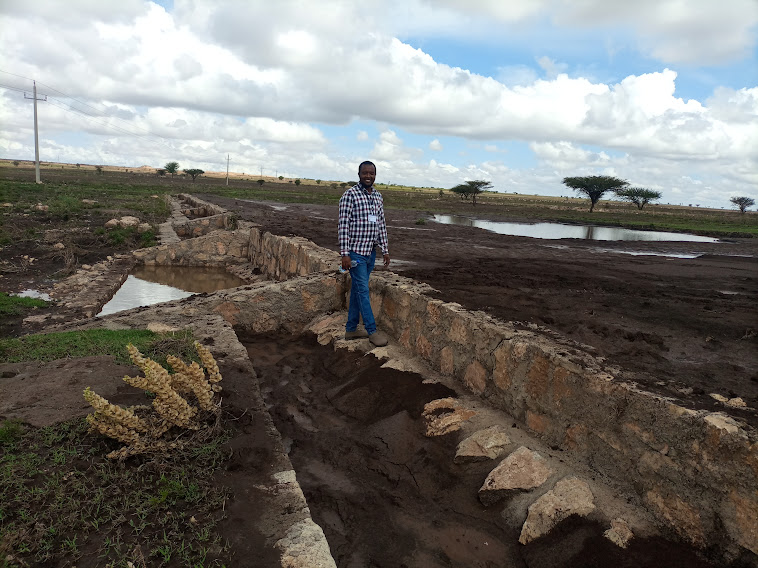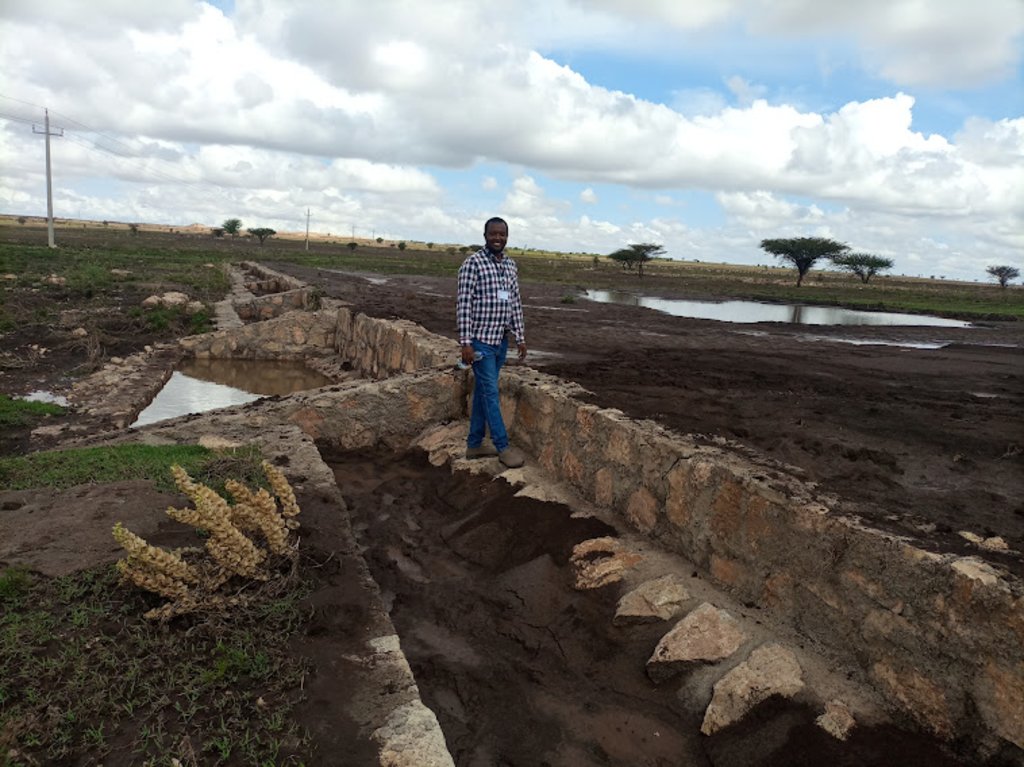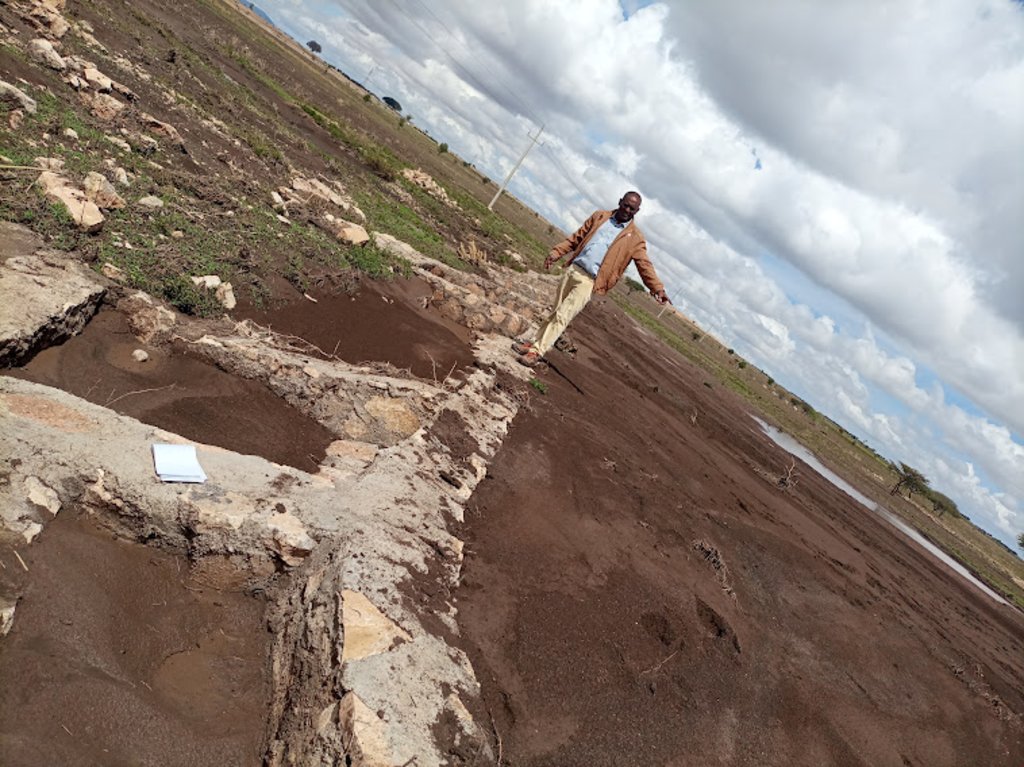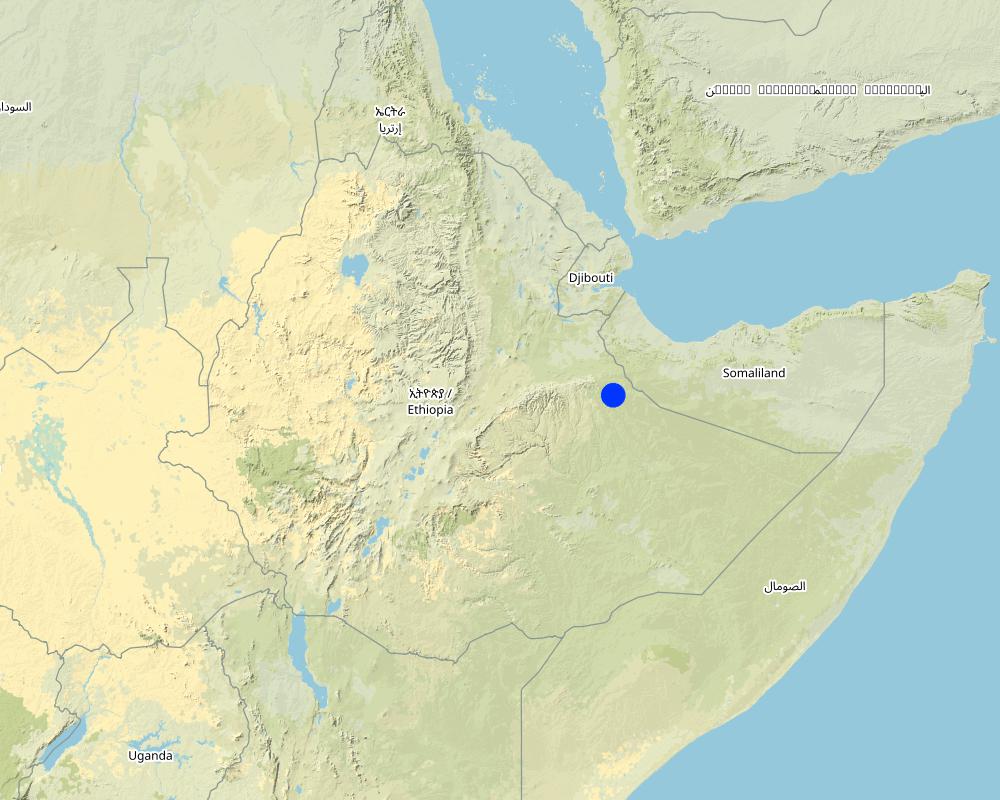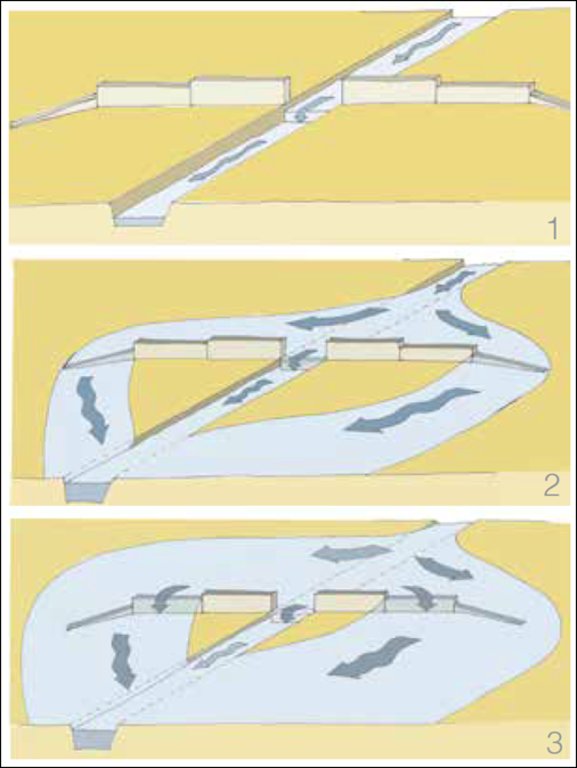Water Spreading Weirs [埃塞俄比亚]
- 创建:
- 更新:
- 编制者: GERBA LETA
- 编辑者: Torben Helbig, Noel Templer
- 审查者: William Critchley, Rima Mekdaschi Studer
Biye Baahiwe
technologies_6715 - 埃塞俄比亚
查看章节
全部展开 全部收起1. 一般信息
1.2 参与该技术评估和文件编制的资源人员和机构的联系方式
关键资源人
SLM专业人员:
Mohamed Badal
Natural Resource Development Protection and Utilization Department of Somali Region Bureau of Agriculture.
埃塞俄比亚
有助于对技术进行记录/评估的项目名称(如相关)
Soil protection and rehabilitation for food security (ProSo(i)l)有助于对技术进行记录/评估的机构名称(如相关)
Alliance Bioversity and International Center for Tropical Agriculture (Alliance Bioversity-CIAT) - 肯尼亚1.3 关于使用通过WOCAT记录的数据的条件
编制者和关键资源人员接受有关使用通过WOCAT记录数据的条件。:
是
1.4 所述技术的可持续性声明
这里所描述的技术在土地退化方面是否存在问题,导致无法被认为是一种可持续的土地管理技术?:
否
注释:
It is soil and water conservation and degraded land rehabilitation technology. Furthermore, the water harvested can be used for spate irrigation and growing food crops and livestock feed.
1.5 参考关于SLM方法(使用WOCAT记录的SLM方法)的调查问卷
2. SLM技术的说明
2.1 技术简介
技术定义:
Water Spreading Weirs are designed to protect the degradation of agricultural fields and rangelands. They contribute to soil and water conservation and enhance the productive use of dry valleys for food crops and livestock fodder production via the harvest and spread of runoff water and fertile soils.
2.2 技术的详细说明
说明:
Water Spreading Weirs (WSWs) spread runoff water to the tips of the structure's wings, slowing down the speed of runoff and arresting the sediment pouring downstream. WSWs are applicable both on farmland and rangelands to improve the productive use of the land’s resources. They protect soil erosion and control gully development as well as increasing surface and sub-surface water availability. Activities such as mobilization of the community through awareness creation are among the numerous tasks implemented to put the technology in place. The community participates in site selection and participatory planning. Other stakeholders assist in area delineation, profiling the implementation area, and design. Labour and inputs such as surveying and construction materials, notably stone, sand, water, and cement, and equipment such as line levels, theodolites, spades, hoes, forks, string and measuring tapes etc. are required. On top of these, implementing the technology is supported by satellite images and ground validation exercises.
The main purpose of the technology is to reduce land degradation, harvest and use runoff water for spate irrigation and household uses, improve environmental resilience to the risks of drought, increase the depth and fertility of land behind the structure by capturing sediment washed away, allow infiltration of water and increase overall production of food and fodder crops. Also, the contribution to groundwater recharge is immense. Furthermore, it allows the agropastoral community to grow both cash and food crops which helps to ensure food security. Above all, the water harvested means people can remain in the area and that their livestock have access to drinking water for about three months after interception of rainfall. However, the agropastoralists may be discouraged by the size of the WSWs which can be from one hundred to over two hundred meters across. Care also must be taken that the structures do not cross livestock migration routes.
2.3 技术照片
关于照片的一般说明:
The photo is trying to portray the water and soil harvested/stopped from running downstream. The detachment and removal of the topsoil without cover and fragile soil types are easily removed and transported to a long distance beyond the regional territory. The trends denied the productive use of land resources. In contradiction, the structure mitigates the loss of water and soil.
2.4 技术视频
注释、简短说明:
Video for this technology was not captured.
2.5 已应用该技术的、本评估所涵盖的国家/地区/地点
国家:
埃塞俄比亚
区域/州/省:
Somali
有关地点的进一步说明:
Amadle kebele, South Jijiga district
具体说明该技术的分布:
- 适用于特定场所/集中在较小区域
技术现场是否位于永久保护区?:
否
注释:
It is located on the farmland used by the extended family and beyond.
Map
×2.6 实施日期
注明实施年份:
2022
如果不知道确切的年份,请说明大概的日期:
- 不到10年前(最近)
2.7 技术介绍
详细说明该技术是如何引入的:
- 通过项目/外部干预
注释(项目类型等):
The technology was put in place in partnership with the government bureau of agriculture and line office with the Capacity Development and Strengthening Drought Resilience (CDSDR) Project of the GIZ in the Somali Region.
3. SLM技术的分类
3.1 该技术的主要目的
- 改良生产
- 减少、预防、恢复土地退化
- 结合其他技术保护流域/下游区域
- 降低灾害风险
- 创造有益的经济影响
3.2 应用该技术的当前土地利用类型
同一土地单元内混合使用的土地::
是
具体说明混合土地使用(作物/放牧/树木):
- 农牧业(包括农牧结合)

农田
- 一年一作
- 多年一作(非木材)
年作 - 具体指明作物:
- 谷物类 - 玉米
- 谷类 - 高粱
- 豆科牧草和豆类 - 大豆
- 蔬菜 - 其他
每年的生长季节数:
- 1
具体说明:
The legume crop is chickpea. Whereas, the vegetables are tomato and onion.
采用间作制度了吗?:
是
如果是,说明哪些作物是间作的:
Maize is intercropped with chickpeas.
采用轮作制度了吗?:
是
如果是,请具体说明:
Cereal crop sorghum rotates with maize and chickpeas. Essentially, crop production suffers from a lack of adequate rainfall. For example, during the last two to three years the area experienced drought. Mainly livestock supports the livelihoods of the inhabitants.

牧场
- Agro-pastoralist
动物类型:
- 骆驼
- cattle - dairy and beef (e.g. zebu)
- 山羊
- 绵羊
是否实行作物与牲畜的综合管理?:
是
如果是,请具体说明:
Essentially, the farming operation is practiced by oxen-plow in which case the animals provide traction force whereas crop residue supply feed to the animals.
产品和服务:
- manure as fertilizer/ energy production
- 肉类
- 奶类
- 交通工具/役畜
注释:
Agro-pastoralism is the common practices in Amadle kebele of south Jijiga district.
3.3 由于技术的实施,土地使用是否发生了变化?
由于技术的实施,土地使用是否发生了变化?:
- 否(继续问题3.4)
3.4 供水
该技术所应用土地的供水:
- 雨养
注释:
The rainfall distribution is erratic with violent erosive feature flooding the plain with severe damage when flowing downstream.
3.5 该技术所属的SLM组
- 农畜综合管理
- 横坡措施
- 灌溉管理(包括供水、排水)
3.6 包含该技术的可持续土地管理措施

结构措施
- S6:墙、障碍物、栅栏、围墙
注释:
The technology is Water Spreading Weirs, stop the run-off and distribute the water across the farmland.
3.7 该技术强调的主要土地退化类型

土壤水蚀
- Wt:表土流失/地表侵蚀
- Wg:冲沟侵蚀/沟蚀
- Wm:块体运动/滑坡

土壤风蚀
- Et:表土流失
- Ed:风蚀风积
- Eo:场外劣化效应

物理性土壤退化
- Pi:覆土

水质恶化
- Ha:干旱化
- Hs:地表水良变化
- Hg:地下水/含水层水位的变化
- Hp:地表水水质下降
- Hq:地下水水质下降
注释:
The technology/structure contributes strongly to soil and water management. The tremendous loss of both resources is immensely reduced by the application of water spreading weirs.
3.8 防止、减少或恢复土地退化
具体数量名该技术与土地退化有关的目标:
- 减少土地退化
- 修复/恢复严重退化的土地
注释:
The technology reduces the speed of runoff, stores the sediments, and distributes the water across the structure which creates an opportunity for spate irrigation and the use of residual moisture as supplemental sources of irrigation for growing early maturing crops.
4. 技术规范、实施活动、投入和成本
4.1 该技术的技术图纸
技术规范(与技术图纸相关):
Spate schemes depending on the increase supply flow:
Part i: The flow of small flood rested channel in the river bed
Part ii: A small or medium flood and overflows pours on the lower wings, &
Part iii: A large flood also pours on high wings.
作者:
Anonymous consultant
4.2 有关投入和成本计算的一般信息
具体说明成本和投入是如何计算的:
- 每个技术单元
指定单位:
1 WSW
指定单位面积(如相关):
Variable ( could be from 100m to over 200m depending on the steepness and width of the farmland.
具体说明成本计算所用货币:
- 美元
注明雇用劳工的每日平均工资成本:
8.414 USD
4.3 技术建立活动
| 活动 | 时间(季度) | |
|---|---|---|
| 1. | Assessing the field (observation) | |
| 2. | Consult the local community along with agricultural partners at different levels | |
| 3. | Surveying and profile data collection | |
| 4. | Develop design and get approval | |
| 5. | Outsource the engineering/masonry works | |
| 6. | Train the masonry workers | |
| 7. | Supply materials | |
| 8. | Implement (execute the excavation and the masonry work) | |
| 9. | Monitor the development (construction supervision) |
注释:
Note: 1 USD = 53.481 Ethiopian birr (ETB) when this data is collected.
4.4 技术建立所需要的费用和投入
如果您无法分解上表中的成本,请估算建立该技术所需要的总成本。:
27490.0
如果土地使用者负担的费用少于100%,请注明由谁负担其余费用:
So far, the project entirely cover the investment and maintenance costs.
注释:
According to the project and regional bureau of agriculture experts, a single structure costs 27, 490 USD. However, in one cascade (dry valley treatment unit) about 8-10 structures are necessary to successfully address the objective of the technology (Soil and Water Management) and ensure productive use of the land from soil arrest and residue of moisture captured in the area. It also enables the use of runoff for spate irrigation.
4.5 维护/经常性活动
| 活动 | 时间/频率 | |
|---|---|---|
| 1. | Assess and identify the damage | During the off-season for ease of access to the sites |
| 2. | Estimate the level and cost of damage | During the off-season |
| 3. | Supply materials | |
| 4. | Employ the masonry worker | |
| 5. | Construct /maintain the damaged parts | Before the short/long rainy season. |
注释:
Maintenance costs are largely associated with the degree of damage and cost of materials and masonry worker or labor costs that consistently changing in current Ethiopia.
4.6 维护/经常性活动所需要的费用和投入(每年)
如果您无法分解上表中的成本,请估算维护该技术所需要的总成本。:
12154.0
如果土地使用者负担的费用少于100%,请注明由谁负担其余费用:
The cost is borne by the project.
注释:
The technical experts give only an estimate of both initial investment and maintenance costs. Variations in materials and labor costs are frequent beyond the imagination. However, maintenance depends on the degree of damage. It seems that maintenance cost estimation takes the highest sides which may dishearten the adoption of the technology in the absence of projects.
4.7 影响成本的最重要因素
描述影响成本的最决定性因素:
Economic crisis and frequently escalating material costs along with rising financial inflation.
5. 自然和人文环境
5.1 气候
年降雨量
- < 250毫米
- 251-500毫米
- 501-750毫米
- 751-1,000毫米
- 1,001-1,500毫米
- 1,501-2,000毫米
- 2,001-3,000毫米
- 3,001-4,000毫米
- > 4,000毫米
指定年平均降雨量(若已知),单位为mm:
750.00
有关降雨的规范/注释:
Rainfall is erratic and erosive. The project site receives rainfall twice a year (Belg- short rain from March to April and Meher- long rain from June to September). However, the number of days on which rain is intercepted is fewer than the ranges stated over here.
注明所考虑的参考气象站名称:
Jijiga Meteorology station
农业气候带
- 半干旱
South Jigjiga district is characterized by hot weather.
5.2 地形
平均坡度:
- 水平(0-2%)
- 缓降(3-5%)
- 平缓(6-10%)
- 滚坡(11-15%)
- 崎岖(16-30%)
- 陡峭(31-60%)
- 非常陡峭(>60%)
地形:
- 高原/平原
- 山脊
- 山坡
- 山地斜坡
- 麓坡
- 谷底
垂直分布带:
- 0-100 m a.s.l.
- 101-500 m a.s.l.
- 501-1,000 m a.s.l.
- 1,001-1,500 m a.s.l.
- 1,501-2,000 m a.s.l.
- 2,001-2,500 m a.s.l.
- 2,501-3,000 m a.s.l.
- 3,001-4,000 m a.s.l.
- > 4,000 m a.s.l.
说明该技术是否专门应用于:
- 凹陷情况
关于地形的注释和进一步规范:
The topography where WSW technology/structures are put in place is mostly on gentle slopes across the dry valley drainage line.
5.3 土壤
平均土层深度:
- 非常浅(0-20厘米)
- 浅(21-50厘米)
- 中等深度(51-80厘米)
- 深(81-120厘米)
- 非常深(> 120厘米)
土壤质地(表土):
- 中粒(壤土、粉土)
土壤质地(地表以下> 20厘米):
- 中粒(壤土、粉土)
表土有机质:
- 低(<1%)
如有可能,附上完整的土壤描述或具体说明可用的信息,例如土壤类型、土壤酸碱度、阳离子交换能力、氮、盐度等。:
The soil ranges from black silty loam to brown silty and fragile soils that are highly vulnerable to flood. It easily detached and moved away with runoff.
5.4 水资源可用性和质量
地下水位表:
> 50米
地表水的可用性:
匮乏/没有
水质(未处理):
不良饮用水(需要处理)
水质请参考::
地下水
水的盐度有问题吗?:
是
具体说明:
As the weather of the area is often too hot salinity is not uncommon in the aquifer.
该区域正在发生洪水吗?:
是
规律性:
偶然
关于水质和水量的注释和进一步规范:
Rainfall is characterized by erratic and erosive nature. Therefore, flooding is common when heavy rain is intercepted.
5.5 生物多样性
物种多样性:
- 低
栖息地多样性:
- 低
关于生物多样性的注释和进一步规范:
Less biodiversity of plant species. Acacias are the common trees, and opuntia and euphorbia species are also common plants in the area. A wild species that may be considered invasive is common in the area. The lower growing weed (wild species) locally known as Weylowed is suggested introduced from Yemen to the Somali part with onion.
5.6 应用该技术的土地使用者的特征
定栖或游牧:
- 半游牧的
生产系统的市场定位:
- 生计(自给)
非农收入:
- 低于全部收入的10%
相对财富水平:
- 贫瘠
个人或集体:
- 个人/家庭
机械化水平:
- 手工作业
- 畜力牵引
说明土地使用者的其他有关特征:
It is the community who are benefiting from the technology. Furthermore, this respondent is a regional SLM specialist. Therefore, specific information on age and gender is not given here though the community was also consulted.
5.7 应用该技术的土地使用者使用的平均土地面积
- < 0.5 公顷
- 0.5-1 公顷
- 1-2 公顷
- 2-5公顷
- 5-15公顷
- 15-50公顷
- 50-100公顷
- 100-500公顷
- 500-1,000公顷
- 1,000-10,000公顷
- > 10,000公顷
这被认为是小规模、中规模还是大规模的(参照当地实际情况)?:
- 小规模的
注释:
Extended family groups of four households are using the land where the WSW is put in place.
5.8 土地所有权、土地使用权和水使用权
土地所有权:
- 社区/村庄
- 个人,未命名
土地使用权:
- 社区(有组织)
- 个人
用水权:
- 社区(有组织)
- 个人
土地使用权是否基于传统的法律制度?:
是
具体说明:
Land use right is based on clan and extended family.
注释:
The land is also owned by individuals. However, there is no land measurement and certification in this region.
5.9 进入服务和基础设施的通道
健康:
- 贫瘠
- 适度的
- 好
教育:
- 贫瘠
- 适度的
- 好
技术援助:
- 贫瘠
- 适度的
- 好
就业(例如非农):
- 贫瘠
- 适度的
- 好
市场:
- 贫瘠
- 适度的
- 好
能源:
- 贫瘠
- 适度的
- 好
道路和交通:
- 贫瘠
- 适度的
- 好
饮用水和卫生设施:
- 贫瘠
- 适度的
- 好
金融服务:
- 贫瘠
- 适度的
- 好
6. 影响和结论性说明
6.1 该技术的现场影响
社会经济效应
生产
作物生产
注释/具体说明:
It is the expert's conviction that crop production in the area increased with water harvest and spread over the farm for use as spate or supplementary irrigation to the seasonal rainfall.
作物质量
注释/具体说明:
As the moisture harvested by the structure is believed to add grain filling period, the crop quality is also expected to increase.
饲料生产
注释/具体说明:
Fodder production also increases with the availability of good soil and moisture conserved in the farm behind the structure.
饲料质量
畜牧生产
注释/具体说明:
Increases with increasing availability of feed or fodder from either crop residue, natural grass or browse.
木材生产
生产故障风险
注释/具体说明:
It rather improves crop resilience because of improved soil moisture.
产品多样性
生产区域
注释/具体说明:
Opportunities can be created to increase the size of land under farming with increasing availability of moisture and fertile soils.
土地管理
注释/具体说明:
Moisture availability eases the management operation.
能源生产
水资源可用性和质量
饮用水的可用性
饮用水的质量
注释/具体说明:
Basically, quality is not a priority issue for agro pastoralists in dry valley areas.
家畜用水的可用性
家畜用水的质量
灌溉用水的可用性
灌溉用水的质量
灌溉用水需求
收入和成本
农业投入费用
注释/具体说明:
As the structure reduces the degree of degradation, expense on agricultural inputs is believed to be reduced.
农业收入
收入来源的多样性
工作量
社会文化影响
食品安全/自给自足
健康状况
土地使用权/用水权
文化机会
娱乐机会
社区机构
国家机构
SLM/土地退化知识
注释/具体说明:
It promotes land users' understanding of SLM through training and exposure to the actual structure and soil and water harvested behind the structure.
冲突缓解
社会经济弱势群体的情况
注释/具体说明:
They may manage to access water for livestock drink and/or household consumption.
生态影响
水循环/径流
水量
水质
水的回收/收集
地表径流
多余水的排放
地下水位/含水层
蒸发
土壤
土壤水分
注释/具体说明:
The structure harvests soil moisture on the farm. It reduces the speed of runoff, stops, and spread over the farm.
土壤覆盖层
注释/具体说明:
Increased through production of more biomass.
土壤流失
注释/具体说明:
The physical barriers stops the soil and water loss.
土壤堆积
土壤结壳/密封
土壤压实
养分循环/补给
盐度
注释/具体说明:
It is related to a warm climate that triggers evaporation and salinity development in the long run.
土壤有机物/地下C
酸度
生物多样性:植被、动物
植被覆盖
生物量/地上C
植物多样性
外来入侵物种
动物多样性
有益物种
栖息地多样性
害虫/疾病控制
减少气候和灾害风险
洪水影响
滑坡/泥石流
干旱影响
飓风、暴雨的影响
碳和温室气体的排放
风速
微气候
对现场影响的评估(测量)进行具体说明:
As the intervention is in its early phase, it is difficult to give an assumption before and after the application of SLM (technology or physical structure). However, a 40 years old woman known as Run Muhamed gave us her insight into the productivity of the land by comparing the hindsight vs the current harvest under highly erratic and erosive rainfall distribution. Accordingly, over the years the harvest per hectare diminished from 0.75 ton/ha to 0.1 ton/ha. This signals the effect of climate change/climate variability and land degradation on crop production. Her household is one of the owners of the land among the other four members of the extended family where the WSW was put in place.
6.2 该技术的场外影响已经显现
水资源可用性
注释/具体说明:
As the structure is recently constructed, it is dire to envisage the off-site impacts of the technology at this juncture. However, it has a positive contribution to the availability of groundwater in the adjacent farms.
旱季稳定可靠的水流
注释/具体说明:
Streams are less common in the dry valley.
下游洪水
注释/具体说明:
It reduces the speed and volume of downstream flooding.
下游淤积
地下水/河流污染
注释/具体说明:
Need an investigation of its impact on the groundwater.
缓冲/过滤能力
风力搬运沉积物
对邻近农田的破坏
对公共/私人基础设施的破坏
温室气体的影响
注释/具体说明:
Believed to reduce it in the long run.
对场外影响(测量)的评估进行具体说明:
The intervention believed to improve the existing negative consequences of degradation through promoting soil and water management and reducing risks of crop failure.
6.3 技术对渐变气候以及与气候相关的极端情况/灾害的暴露和敏感性(土地使用者认为的极端情况/灾害)
渐变气候
渐变气候
| 季节 | 增加或减少 | 该技术是如何应对的? | |
|---|---|---|---|
| 年温度 | 增加 | 适度 | |
| 年降雨量 | 减少 | 好 |
气候有关的极端情况(灾害)
气象灾害
| 该技术是如何应对的? | |
|---|---|
| 局地暴雨 | 适度 |
| 当地沙尘暴/尘暴 | 不好 |
气候灾害
| 该技术是如何应对的? | |
|---|---|
| 干旱 | 适度 |
水文灾害
| 该技术是如何应对的? | |
|---|---|
| 山洪暴发 | 适度 |
注释:
After an extended dry year, like this season, the technology is overloaded with a flash flood. The soil was frequently exposed to the sun and the prevailing heat waves in the area were easily detached by torrential rain. Then the soil and water were partly arrested whereas an immense amount washed away. It seldom could topple the structure if not the cascade comprises eight to ten structures with relatively short intervals to support one another. Furthermore, the dry valley soil is very fragile let alone exposed to a long-term drought that is associated with a heavy shower at the beginning of a short season like this season.
6.4 成本效益分析
技术收益与技术建立成本相比如何(从土地使用者的角度看)?
短期回报:
积极
长期回报:
非常积极
技术收益与技术维护成本/经常性成本相比如何(从土地使用者的角度看)?
短期回报:
积极
长期回报:
非常积极
6.5 技术采用
- 单例/实验
注释:
It is a technology implemented at the community or extended family level. It is too early to evaluate the adoption trend at this particular time.
6.6 适应
最近是否对该技术进行了修改以适应不断变化的条件?:
否
6.7 该技术的优点/长处/机会
| 土地使用者眼中的长处/优势/机会 |
|---|
| The technology/structure reduce soil and water erosion. |
| Harvest water and make the people and livestock beneficiaries from the still water for crop production, drinking, and household uses. |
| Increase soil moisture and risks of crop failure because of shortage of rainfall. |
| 编制者或其他关键资源人员认为的长处/优势/机会 |
|---|
| Rehabilitate both degraded agricultural and grazing lands. |
| Improve agropastoralist access to livestock feed and benefit from the positive impact caused by the technology. |
| Eventually, contributes to the improvement of ecology and overall ecosystem functioning. |
6.8 技术的弱点/缺点/风险及其克服方法
| 土地使用者认为的弱点/缺点/风险 | 如何克服它们? |
|---|---|
| High initial investment cost. | Enhance the in-kind contribution of the land users, and increase matching funds from the government as cost-sharing with other projects. |
| Agropastoralist complains about the space it occupies in their farmland regardless of the benefit they accrue over a long period. | Increase the awareness of the community on the productive uses of the degrading land based on the evidence. |
| The structure may fall over the livestock migration/travel routes that are not acknowledged by some members of the community. | During masonry work, precaution is essential to calm down the possible complaints that could emerge because of the raised structure by leveling the crossover roads/paths. |
| 编制者或其他关键资源人员认为的弱点/缺点/风险 | 如何克服它们? |
|---|---|
| An inadequate number of structures in a cascade subjected to ineffective soil and water management and distribution of rainwater to support as supplementary sources of moisture for crop production. | Increase the number of structures per conceptual statement and standardize the intervals between the structures. |
| Excessive land users' desire that is unassociated with a tangible contribution to the development of the technology from their side. | Further building land users understanding of SLM technologies and their benefits so that they can build a sense of ownership and accountability to contribute and complement the external efforts. |
| Land users give emphasis mainly on the immediate benefits of the technology (harvesting water for livestock drinking and household use) than the objectives of rehabilitating the dry valley for productive use of it such as crop and livestock feed production. | Acknowledging the immediate benefits, and the mainstreaming work regarding the pillar objectives of the project intervention. |
| The initial investment, as well as maintenance costs, are either expensive or overestimated by local actors. Such a higher cost may discourage land users in the absence of projects or SLM funds. | It would be good to be pragmatic in cost estimation. Furthermore, adapting the technology using local materials may promote the adoption and sustainability of the structure for widespread use. |
7. 参考和链接
7.1 信息的方法/来源
- 实地考察、实地调查
Three individuals.
- 与土地使用者的访谈
One person.
- 与SLM专业人员/专家的访谈
Four individuals.
(现场)数据是什么时候汇编的?:
23/03/2023
7.2 参考可用出版物
标题、作者、年份、ISBN:
Mekdaschi & Linger, 2013. Freie Universitat Berlin
可以从哪里获得?成本如何?
https://www.geo.fu-berlin.de/en/v/iwrm/Introduction/Principles/index.html
7.3 链接到网络上的相关信息
标题/说明:
Water-spreading weirs
URL:
https://www.unccd.int/best-practice/water-spreading-weirs
标题/说明:
Water Spreading Weir - NATURAL RESOURCE MANAGEMENT
URL:
https://nrmdblog.wordpress.com/2016/12/12/water-spreading-weir/
7.4 一般注释
The questionnaire is inclusive and more relevant to evaluate such physical structures as a technology. However, successive drought seasons experienced in the area subject the fragile soil to be easily detached and immensely moved by the early rains past the structure. This may affect the valuation of the efficiency of the technology since dry areas are also characterized by a flash flood that could certainly mask the benefits of such a good technology.
链接和模块
全部展开 全部收起链接
无链接
模块
无模块


